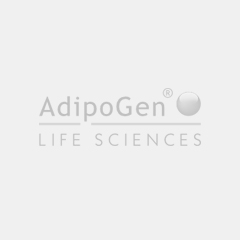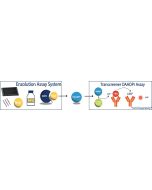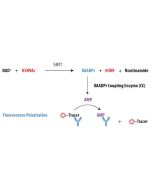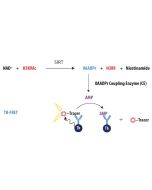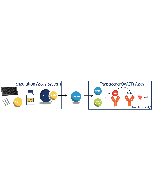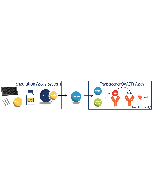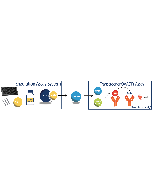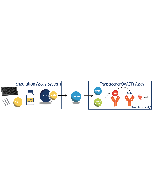Cookie Policy: This site uses cookies to improve your experience. You can find out more about our use of cookies in our Privacy Policy. By continuing to browse this site you agree to our use of cookies.
BellBrook
SIRT3 (human) (rec.) (His) (active) (100µg)

| Product Details | |
|---|---|
| Synonyms | Sirtuin3; NAD-dependent Deacetylase Sirtuin-3; SIR2-like Protein 3 |
| Product Type | Protein |
| Properties | |
| Source/Host | E. coli |
| Sequence |
Human SIRT3 (aa 101-399) protein with a N-terminal His-tag. |
| Crossreactivity | Human |
| Application |
Drug Discovery |
| Biological Activity |
The enzyme has been thoroughly validated with the Transcreener OAADPr SIRT Assay Kit. |
| MW | 33.7kDa |
| Purity | ≥95% (SDS-PAGE) |
| Concentration | Lot dependent. |
| Accession Number | Q9NTG7 |
| Formulation | Liquid in 50mM HEPES, 200mM NaCl, 1mM TCEP, 1mM EDTA, 10% Glycerol (pH 7.5). |
| Other Product Data |
Click here for Complete Information from the Original Manufacturer Our product description may differ slightly from the original manufacturer's product datasheet. Human SIRT3: Q9NTG7 |
| Shipping and Handling | |
| Shipping | DRY ICE |
| Short Term Storage | -20°C |
| Long Term Storage | -80°C |
| Handling Advice | Avoid freeze/thaw cycles. |
| Use/Stability | Stable for at least 6 months after receipt when stored at -80°C. |
| Documents | |
| Product Specification Sheet | |
| Datasheet |
 Download PDF Download PDF |
Sirtuins (Silent information regulators; SIRTs) deacetylate and/or ADP-ribosylate lysine residues of target proteins in an NAD+-dependent manner. Sirtuins are critical regulators of many cellular processes, including insulin secretion, the cell cycle and apoptosis. Sirtuins, in particular SIRT1, emerged as critical regulators of longevity and aging in several model organisms. Furthermore, a variety of age-associated diseases such as type 2 diabetes, obesity, osteoporosis, and Alzheimer’s disease are associated with sirtuins. Sirtuin-2 (SIRT2) is a NAD-dependent protein deacetylase, which deacetylates the 'Lys-40' of a-tubulin. It is involved in the control of mitotic exit in the cell cycle. Furthermore, a variety of age-associated diseases such as type 2 diabetes, obesity, osteoporosis, and Alzheimer’s disease are associated with sirtuins. Selective inhibition of Sirtuin-2 achieves neuroprotection and identifies Sirtuin-2 to be a potential therapeutic avenue in Huntington’s and Parkinson’s disease. Sirtuin-3 (SIRT3) promotes fatty acid oxidation, ATP production and antioxidant defense. It acts as a crucial mediator of metabolic adaptation under conditions such as fasting or caloric restriction. Loss or reduced activity of SIRT3 has been associated with metabolic disorders, aging, and cancer progression, highlighting its importance in maintaining mitochondrial and cellular homeostasis.






